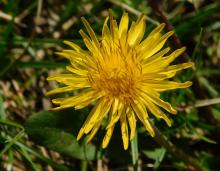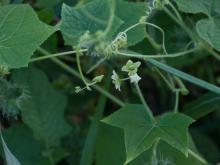Wildflowers, Grasses and Other Nonwoody Plants
Media

Species Types
Scientific Name
Asplenium platyneuron
Description
Ebony spleenwort is a common forest-floor fern with wiry, shiny, dark brown leaf stalks and a ladderlike series of dark green, narrowly oblong leaflets.
Media

Species Types
Scientific Name
Pellaea atropurpurea
Description
Purple cliff brake is a fern that grows from crevices in limestone and dolomite rocks, or in rocky soils near them. Its leathery, blue-gray leaflets, which are oval to lance-shaped, make the fronds seem not very fernlike.
Media

Species Types
Scientific Name
Pellaea glabella
Description
Smooth cliff brake is almost always seen growing out of an exposed limestone or dolomite bluff or rock. Its fronds, with blue-gray, lance-shaped, ovate, or oblong leaflets, are not very fernlike.
Media

Species Types
Scientific Name
Pteridium aquilinum
Description
Bracken is a fern found nearly worldwide. Its 2–3 times compound leaves are triangular in outline and arise singly from the underground creeping rhizome.
Media

Species Types
Scientific Name
Taraxacum officinale
Description
The common dandelion is a well-known common weed of lawns, roadsides, and other disturbed places. Originally from Europe, it occurs nearly worldwide.
Media

Species Types
Scientific Name
Sicyos angulatus
Description
Bur cucumber is a nonwoody, native, annual vine common in low, moist soils. It can spread across an area 20 feet wide, covering the ground and nearby shrubs. Note its lobed, gourd-family leaves, curly green tendrils, clusters of prickly, green, oval fruits, and 5-lobed, cream-colored flowers.
Media

Species Types
Scientific Name
Viola spp.
Description
Violets, as a group, are fairly easy to identify, with their colorful five-petaled “faces” so welcome in springtime. Missouri has 17 species, and some are confusingly similar. This page introduces them as a group.
Media

Species Types
Scientific Name
Viola palmata (syn. V. triloba)
Description
The leaf blades of cleft violet are highly variable, and the plant produces differently shaped leaves as the season progresses. Midseason leaves have a broad central lobe flanked by additional lobes toward the base.
Media

Species Types
Scientific Name
Packera spp. (formerly Senecio spp.)
Description
Ragworts, or groundsels, have several common names, and separating the different species can be a little tricky. But members of genus Packera, with their bright yellow daisy-like flowers, are distinctive as a group. Seven species have been recorded in Missouri.
Media

Species Types
Scientific Name
Packera plattensis (formerly Senecio plattensis)
Description
Prairie ragwort is one of seven Packera species in our state. It grows in sunny, open habitats. Look for its clusters of bright yellow, daisylike flowers in May and June.
See Also
About Wildflowers, Grasses and Other Nonwoody Plants in Missouri
A very simple way of thinking about the green world is to divide the vascular plants into two groups: woody and nonwoody (or herbaceous). But this is an artificial division; many plant families include some species that are woody and some that are not. The diversity of nonwoody vascular plants is staggering! Think of all the ferns, grasses, sedges, lilies, peas, sunflowers, nightshades, milkweeds, mustards, mints, and mallows — weeds and wildflowers — and many more!





















